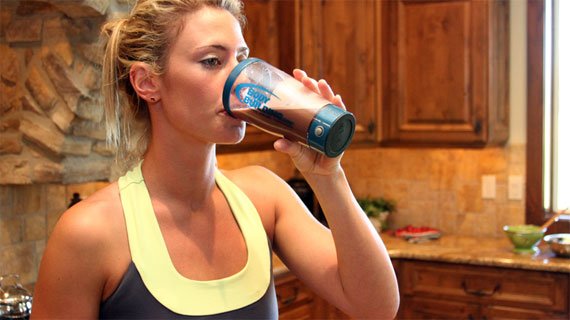I'm trying to gain size, and for years I've heard that I should consume simple sugars immediately post-workout to generate an anabolic insulin response. Then I hear horror stories about sugar, how it can mess up my blood sugar and lead to fat gain. Who's right?
Both are correct. Using sugar to stimulate insulin in order to maximize anabolism during the post-workout window is smart. But sugar can also wreak havoc on your blood sugar levels, causing fat storage and hurting your overall health.
Because the sugar/insulin connection is a double-edged sword, timing is key.
First, let's look at the benefits. Insulin plays an important role in protein synthesis and recovery during and following your workouts. Here's what insulin does during this 3-to-5-hour window.
It helps stop workout associated muscle loss: Breaking down muscle during a workout so that you can build it back up stronger is essential for continual growth and development of your physique.
However, breaking down muscle during your workout, only to have your body use it as fuel, is not.
Simple carbohydrates taken in just before, during, and after your workout will strategically stimulate the hormone insulin. Insulin works to counteract the hormone cortisol. Cortisol is a catabolic hormone that becomes elevated during your training sessions. It's a primary driver of muscle breakdown.
It helps improve post-workout insulin sensitivity: Right after you finish your workout, your muscles' insulin sensitivity is the best it will be all day.
This means that the carbohydrates and amino acids that you take in during and directly following your workout will be preferentially shuttled to your muscles for repair and growth.
Research also suggests that having a post-workout shake will further enhance your insulin sensitivity for the next 12 to 24 hours, making it more likely that the food you eat the rest of the day will be used for good (muscle building) and not bad (growing new fat cells).
In addition to braking on workout-associated muscle loss and enhancing post-workout insulin sensitivity, post-workout simple sugars help refill and replenish your muscle-energy stores.
That's the good; here's the bad:
Outside of a workout context, simple sugars will wreak havoc on your blood sugar control and waistline.
Here's how. It's very easy to consume lots of simple sugars very quickly. When was the last time you saw someone drink half a can of Coke and throw the rest away?
Simple sugars are also very fast acting, meaning they're lightening-quick into your blood stream, spiking your blood sugar.
Your body needs to keep your blood sugar levels within a set range, so it releases insulin to take care of cleanup. But if you aren't in the post-workout window, insulin will move the sugar you just consumed out of your blood and into fat cells.
While doing this, it will also flip three major metabolic switches, which will:
- Turn off the release of fat from fat cells (i.e., fat burning)
- Turn on the conversion of sugar to fat within fat cells (i.e., increasing body-fat storage)
- Turn (way) down your body's ability to burn fat for energy (i.e., negatively affect nutrient partitioning)
By timing your simple carbs correctly, you can maximize their good effects while minimizing these bad effects.
Here's how to put it all together in your diet:
The only foods that you are eating which contain a significant amount (>10-15 grams) of added sugar should be your workout nutrition shake.
Start sipping on your shake 20-30 minutes prior to your training and continue to sip on it during your training session. If you have any left when you're done with your session, finish it before leaving the gym floor.
Consume your next meal 45 to 60 minutes after the session ends. It shouldn't contain simple sugars, but it should contain a large portion of faster-acting carbohydrates such as rice, pasta, whole-grain bread, or quinoa.

If your main focus is building more muscle, repeat this meal (or one with similar carbohydrates) 2 to 3 hours later.
If your goal is more fat loss, when you eat your next meal, start shifting the types of carbohydrates on your plate to fruits, vegetables, and beans/legumes.
Continue eating these types of carbohydrates until your next training session, when you ramp up the simple sugars again.
Proper timing will allow you to maximize the muscle-building upside of simple sugars while minimizing their waistline-expanding, health-deteriorating downside.

